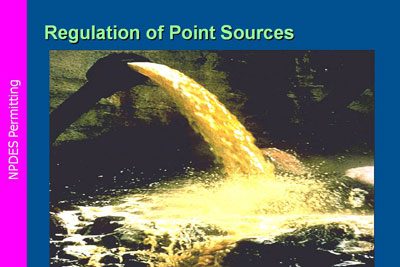NPDES Program, continued
NPDES permits cover industrial and municipal discharges, discharges from storm sewer systems in larger cities, stormwater associated with numerous kinds of industrial activity, runoff from construction sites disturbing more than one acre, mining operations, and animal feedlots and aquaculture facilities above certain thresholds.
Special Exemptions
- A number of types of discharges that meet the definition of a “point” source are not required to obtain an NPDES permit because of either statutory (congressional) or administrative (EPA) exemptions. These include the following:
- Abandoned mines on nonfederal lands (state, local, private)
- Sewage (not other types of discharges) from ships covered by EPA’s Vessel Sewage Discharge Program
- Return flows from irrigated agriculture
- Most drainage ditches associated with logging roads
- Some energy-related facilities
- Most smaller feedlots and aquaculture facilities
Also, all so-called “indirect” dischargers are not required to obtain NPDES permits. The drawing explains the difference between “direct” and “indirect” discharges [Link to slide #72 below]. An indirect discharger is one that sends its wastewater into a city sewer system, so it eventually goes to municipal treatment plants, which are commonly called “publicly owned treatment works” (POTWs). Though not regulated under NPDES, “indirect” discharges are covered by another CWA program, called pretreatment. All permits state their issuance and expiration date. In accordance with the CWA, permit terms may not exceed five years. EPA’s regulations require that permit applications be submitted to the permitting authority 180 days before discharge (if a new discharger) or permit expiration (if already an NPDES permit holder).
Who is responsible for drafting and issuing the permits?
The first thing to determine is whether the state is “authorized” to administer the NPDES program. This authorization (sometimes referred to as delegation or primacy) is granted by EPA to a state if it can demonstrate that it has a program at least as stringent as EPA’s regulations. Nearly all states are authorized to manage the NPDES permitting program in their jurisdictions—for more information, see the State and Tribal Program Authorization Status. As of 2010, 46 states are authorized to administer the NPDES program.
Web Resources
National Pollutant Discharge Elimination System homepage
![[logo] US EPA](https://www.epa.gov/epafiles/images/logo_epaseal.gif)
